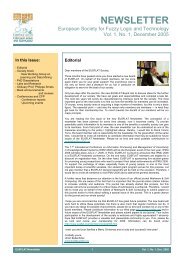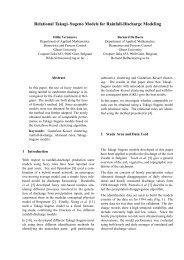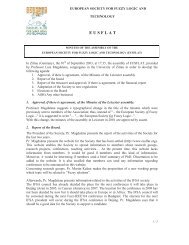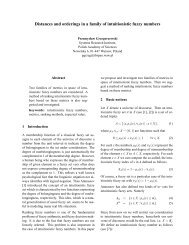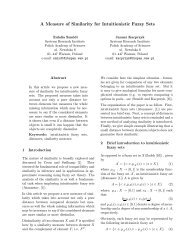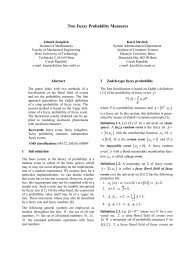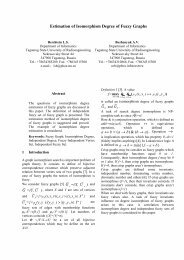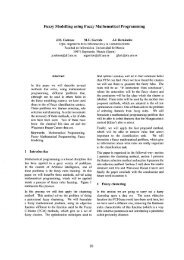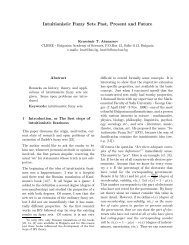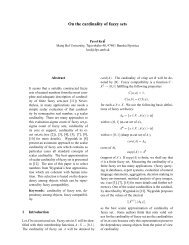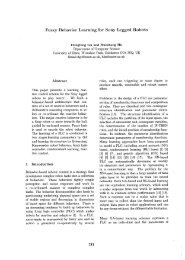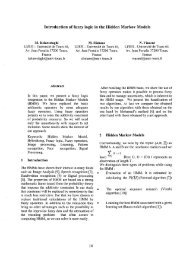Ant Colony Optimization for Distributed Routing ... - ResearchGate
Ant Colony Optimization for Distributed Routing ... - ResearchGate
Ant Colony Optimization for Distributed Routing ... - ResearchGate
You also want an ePaper? Increase the reach of your titles
YUMPU automatically turns print PDFs into web optimized ePapers that Google loves.
The pheromone value is the result of pheromone laying by<br />
previous artificial ants and represents the long-term goodness<br />
of selecting the fibre link from i to j to route the F-EAP,<br />
whereas the heuristic value corresponds to the instantaneous<br />
goodness of selecting this fibre link. In order to compute ηij,<br />
the wavelength availability of the fibre link ij is assessed by<br />
determining if the fictitious data burst could be scheduled on<br />
each of the W wavelengths of the fibre link. Let ij denote<br />
the number of available wavelengths to schedule the data<br />
burst on this fibre link. The heuristic value ηij is given by<br />
= Wˆ W . (4)<br />
ij ij<br />
The link state weight α determines the importance of the<br />
instantaneous resource availability of the fibre link over its<br />
long-term pheromone concentration.<br />
The node selected j* is added to the F-EAP, as well as the<br />
number of available wavelengths ij*. When it reaches the<br />
egress node, the artificial ant is switched to B-EAP.<br />
4.3 Pheromone Table Update by Backward Explorer <strong>Ant</strong>s<br />
The B-EAP follows the reverse path of the F-EAP, updating<br />
the pheromone tables in each node. In an OBS network, the<br />
average burst blocking probability on a fibre link can be<br />
estimated with the Erlang-B <strong>for</strong>mula, assuming an average<br />
offered traffic load of x and a Poisson burst arrival process,<br />
( )<br />
k= 0 <br />
The wavelength availability ij, collected by the F-EAP,<br />
is used to estimate the traffic load offered to the fibre link<br />
between i and j as x = W – ij. Under the link independence<br />
assumption [14], the average burst blocking probability in<br />
the routing path between nodes s and d can be estimated by<br />
| VEAP<br />
| −1<br />
sd<br />
B = 1 − (1 ˆ ∏ −B<br />
vv ) , (6)<br />
k k+<br />
1<br />
k=<br />
1<br />
−1<br />
W<br />
W k <br />
Erl( xW , ) = x W! ⋅ x k!<br />
. (5)<br />
<br />
where { v 1, v2<br />
, ..., vk<br />
, ..., v|<br />
V | } denotes the ordered set of the<br />
EAP<br />
nodes visited by the F-EAP and B ˆ<br />
vv the average burst<br />
k k+<br />
1<br />
blocking probability in the fibre link between vk and vk+1. The<br />
goodness of a routing path is quantified in DABR as<br />
sd sd<br />
q = 1 B . (7)<br />
Each node i maintains the goodness of the best solution<br />
sd<br />
qbest estimated by the previous Q artificial ants between s<br />
and d and the pheromone rein<strong>for</strong>cement value r is given by<br />
sd sd sd sd<br />
q<br />
qbest , q < qbest<br />
r = . (8)<br />
1, otherwise<br />
In order to enhance the rewarding of good solutions (high<br />
values of r), while saturating the rewards <strong>for</strong> low values of r,<br />
the following squash function s(x) is used [5],<br />
ISBN: 978-989-95079-6-8<br />
−1<br />
EAP | |<br />
1 <br />
s ( x)<br />
= 1+<br />
exp <br />
<br />
<br />
<br />
<br />
<br />
r V <br />
, (9)<br />
r ← ⋅ s() r s(1)<br />
, (10)<br />
max<br />
IFSA-EUSFLAT 2009<br />
where τmax is the maximum pheromone value that a single<br />
artificial ant can deposit. This parameter is used to regulate<br />
the impact of a single artificial ant on the pheromone tables.<br />
The pheromone update has to ensure a minimum amount<br />
of pheromone τmin uni<strong>for</strong>mly divided by the adjacent nodes,<br />
sd<br />
ik ≥ min | Ai|, k∈ Ai,<br />
(11)<br />
and it also has to guarantee that equation (1) holds. Hence,<br />
the following expressions have been devised <strong>for</strong> updating the<br />
pheromone value associated to the adjacent node j the F-EAP<br />
has used and that associated to the remaining adjacent nodes,<br />
( 1 min (| | 1) | | )<br />
( min | | ) , ,<br />
sd sd sd<br />
ij ij r ij AiAi τ ← τ + ⋅ −τ − ⋅ − , (12)<br />
sd sd sd<br />
ik ik ik i i<br />
τ ←τ −r⋅ τ − A k∈A k ≠ j.<br />
(13)<br />
In case the update has modified the adjacent node that has<br />
the highest pheromone value, designated as the dominant<br />
adjacent node, a specific flag of the B-EAP is activated.<br />
4.4 <strong>Routing</strong> Table Update and Circular Path Avoidance<br />
In the initial implementation of DABR, data bursts were<br />
routed through the path obtained from the adjacent nodes<br />
with the largest pheromone concentration. However, it was<br />
found that circular paths were occasionally <strong>for</strong>med, which<br />
resulted in data bursts getting trapped on a loop. Although<br />
these paths are only temporary, the resulting communication<br />
disruption is not tolerable in a high capacity optical network.<br />
Hence, it is imperative to include in DABR a mechanism to<br />
avoid the <strong>for</strong>mation of circular paths. The novel mechanism<br />
devised <strong>for</strong> this purpose separates the pheromone and routing<br />
tables, guaranteeing that the update of the routing paths<br />
never allows the <strong>for</strong>mation of loops without introducing<br />
additional restrictions to the update of the pheromone tables.<br />
sd<br />
Let v i denote the adjacent node of node i used <strong>for</strong><br />
routing data bursts from node s to node d. The update of the<br />
routing path between s and d is triggered by the arrival at<br />
node s of a B-EAP with the flag that signals a new dominant<br />
adjacent node activated. As a result, node s generates a F-<br />
RAP directed to node d. This control packet includes a list to<br />
record the nodes it visits. At each node i the F-RAP visits,<br />
the dominant adjacent node j* is determined, that is,<br />
*<br />
j = arg max τ<br />
j∈Ai sd { }<br />
ij<br />
, (14)<br />
and compared with the nodes previously visited. In case node<br />
j* has already been visited, a loop is detected and the F-RAP<br />
is discarded, keeping the routing path unchanged. Otherwise,<br />
the F-RAP adds the dominant adjacent node j* to the list of<br />
nodes visited and moves to it. In case j* = d, the new routing<br />
path is non-circular. Thus, the F-RAP is switched to B-RAP,<br />
follows the inverse path and, at each node i, the adjacent<br />
node used to route data bursts, sd<br />
v i , is updated to be the<br />
same as the node visited by the F-RAP immediately after i.<br />
The routing of data bursts in DABR is determined by the<br />
routing tables of the nodes. In particular, when a BHP,<br />
preceding the correspondent data burst, arrives at node i, the<br />
sd<br />
node determines the next node of the data burst from v i .<br />
181



